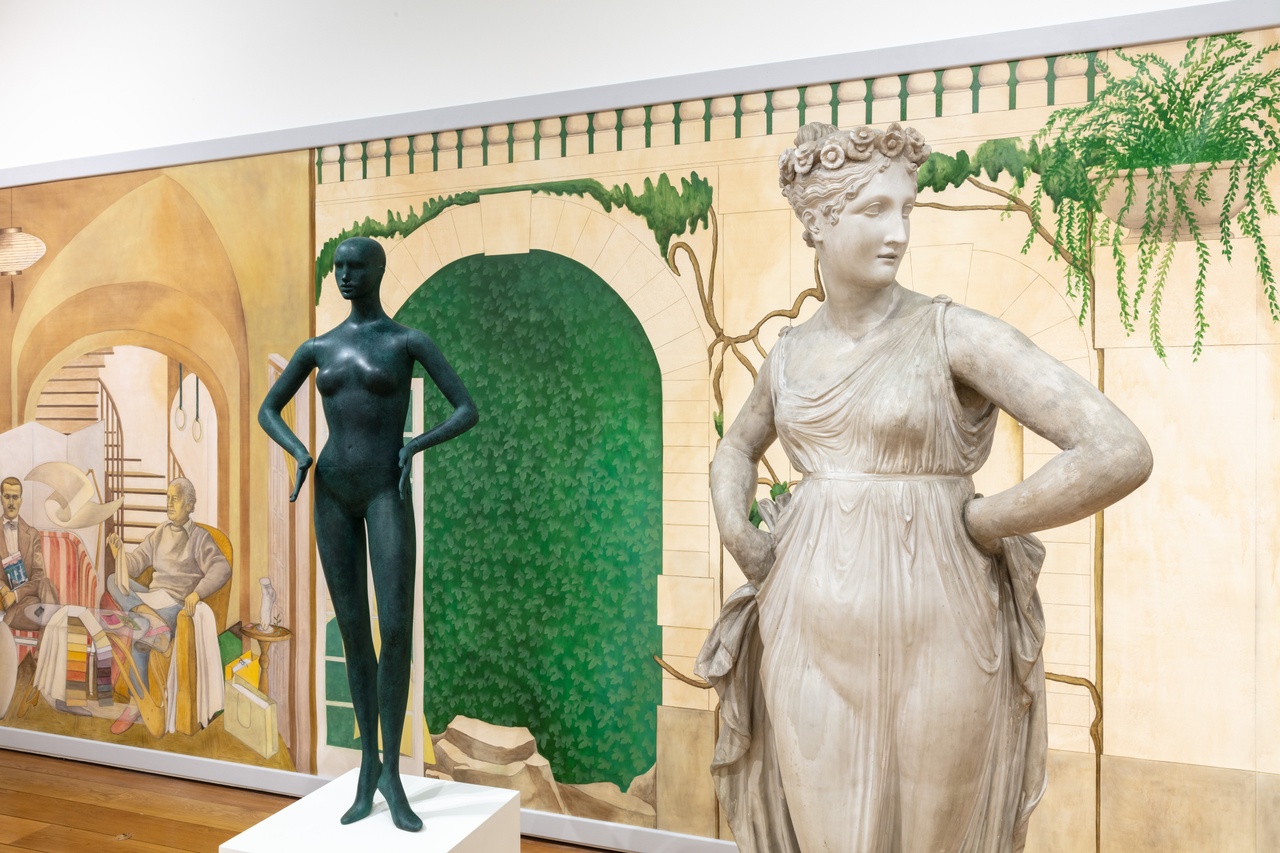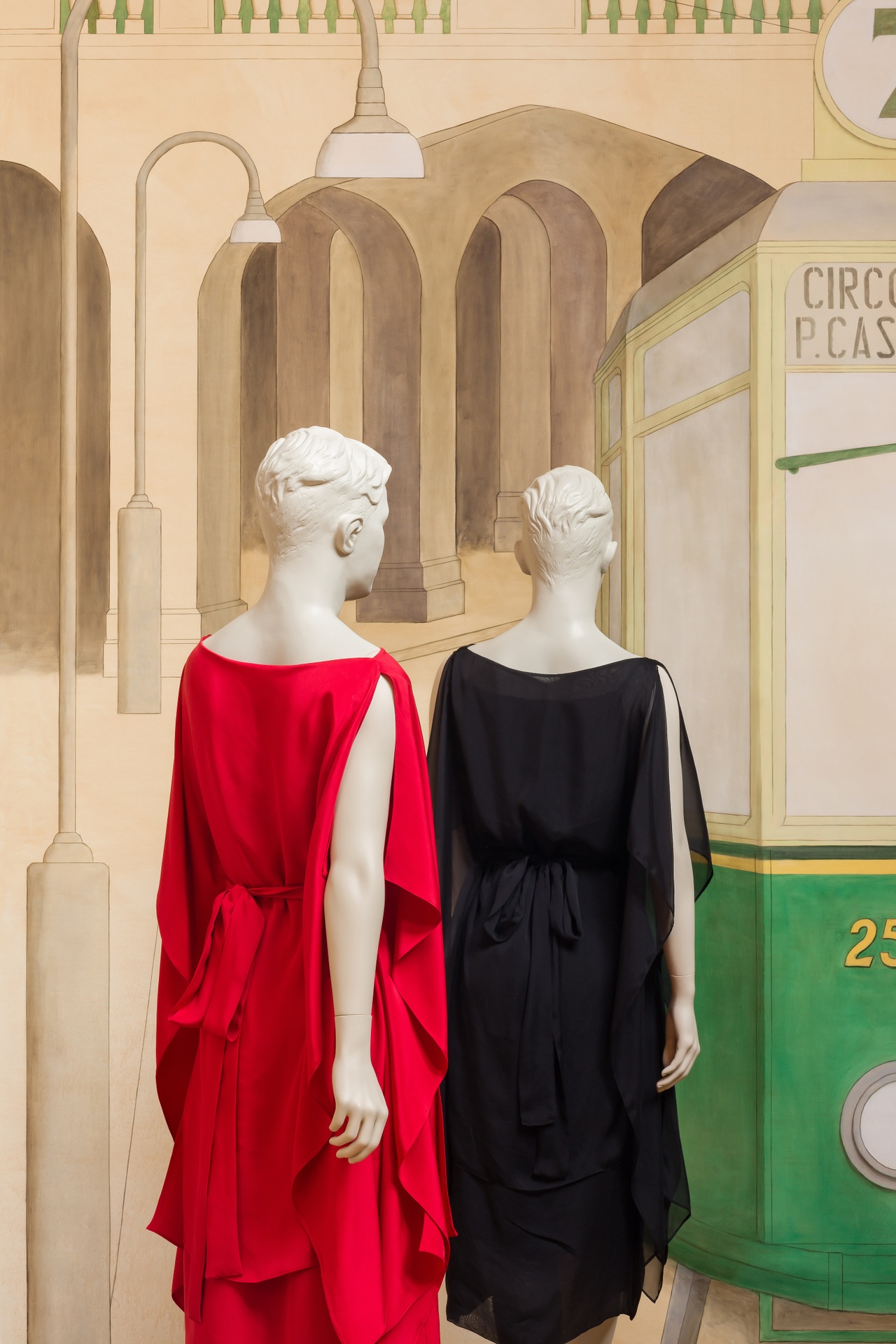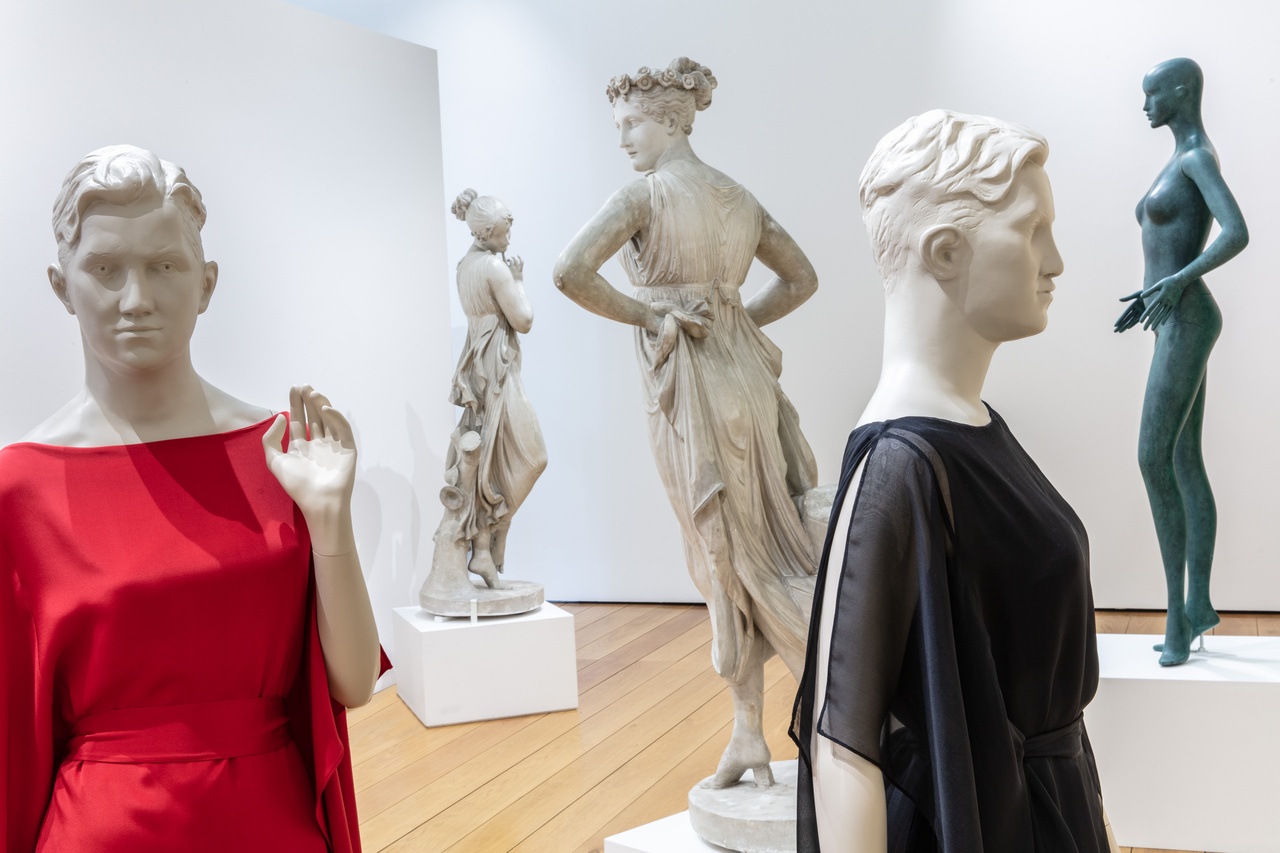ALL FORM, NO CONTENT Rose Higham-Stainton on Lucy McKenzie (and Antonio Canova) at Pinacoteca Agnelli, Turin

“Lucy McKenzie and Antonio Canova: Vulcanizzato,” Pinacoteca Agnelli, Turin, 2023-24, installation view
When an image or a form is produced and then reproduced, and perhaps one day proliferates, it lodges in the mind, and later, the cultural consciousness. We come to know it, we become familiar with it, perhaps overfamiliar, and then one day it loses meaning, becomes indiscernible from another image, or form. This recapitulation and dilution of image or form – their levelling into the social imaginary – is the crux of neoclassicism and the central preoccupation of “Vulcanizzato,” part of a program that invites artists to respond to the museum’s permanent collection. For “Vulcanizzato,” Lucy McKenzie chose two of Antonio Canova’s plaster cast sculptures, Dancing Girl with Her Hands on Her Hips (1811–12) and Dancing Girl with Her Finger on Her Chin (1809–14), which confirm and reproduce, but also politicize, the feminine form – something McKenzie is interested in across statuary, sculpture, and fashion – alongside the lasting impact of the neoclassic era.
To witness the work of neoclassical sculptor Antonio Canova is to be privy to the machinations of ascent and its relation to beauty. Commissioned by the Hapsburg court, Napoleon, and the Papal Church, Canova sought power by conflating an image of beauty with a concept of morals, while outside, the world was strewn in the blood and dirt and gunpowder of the Napoleonic wars. Rendered in marble or cast in plaster, treated, and finished with pink wax, amber or “rotted water” [1] to simulate the color of flesh, the perceived realism of Canova’s works as well as his finishing touches had broad social ramifications. It assumed classicism, and thus neoclassicism: Caucasian, deeply gendered, and confined to the perspective of a man, or a master artist – assumptions that McKenzie wants to unpick. By shaping the idea of classicism – what McKenzie calls an “effortless legibility,” a “purity of surface” and “decorative cohesion” [2] – as a blueprint for taste and beauty, Canova was also shaping society, and on another level, morality: the idea of what is good and what is bad, what good and bad look like, what good and bad bodies look like. For Canova and other neoclassicists, the fabrication and reproduction of the body became a means of propaganda (as it was for the Fascists and the Romans long before them). This was emboldened by the introduction of the production line into art-making; with a team of workers fabricating his designs in exquisite marble, Canova could circulate his works widely among nobility and aristocrats.
The layers of ascent, both physical and social, to reach Canova’s work is fitting. To visit the installation, we travel up through the Lingotto – a vast postindustrial complex and former home to Giovanni Agnelli’s Fiat factory – and up through the shopping precinct that replaced it. Up through the gallery spaces – a project in art-collecting and exhibition-making by the Agnelli family – and up through the racetrack that they built on the roof and the sculpture park that now resides there. Up and above metal and tarmac and projected into the heavy sky of Turin is a modernist picture gallery housing 25 works acquired by the Agnelli family and now held by the Pinacoteca. Among this small canonical and thus potted history of Western art are two plaster cast sculptures by Canova based on ancient, but heavily reproduced, wall paintings from the first century BCE, the so-called Herculaneum Dancers. Much like Canova’s other great muses – the three daughters of Zeus which he imagines in The Three Graces (1814) – these dancers personify elegance, grace, and beauty in the wooliest sense, while completely void of distinctions; names and identities, and perhaps also feelings, are broken down into body parts and named accordingly, after their fingers, chins, hands, and hips.

“Lucy McKenzie and Antonio Canova: Vulcanizzato,” Pinacoteca Agnelli, Turin, 2023-24, installation view
This is where Lucy McKenzie enters – also into a dialogue with Canova – approximating the formation of an early 19th-century walled sculpture garden from a long shallow room of the Pinacoteca. Alongside the two Canovas, we encounter three of McKenzie’s sculptures – approximates of mannequins – and one of her hyperreal trompe l’oeil murals, all of it contained by a partition wall. Space is limited, interpolating us into the garden and imploring us to move around and between the sculptural works and to go right up to the mural. Such intimacy demands us to view or consume the entire thing in parts, but also its various parts at the same time: one sculpture is always flanked by another or framed by the mural in the background. This layered and fractal experience of associated images and forms speaks to Canova’s reproduction of bodies and the way in which 3D digital technology is used in museums to scan and reproduce open-source images of antique statuary, or is used by artists to scan living models and cast them in bronze or CNC mill them from marble, thus to reify certain bodily and gendered ideals.
It is because of and despite the oversimplification of the body in commercial mannequins in particular that McKenzie has arrived here. Working at the interstices of visual art, fashion, design and decoration, the artist uses display mannequins – sometimes known, questionably, as dummies – to start conversations around the politicization of the body. In “Vulcanizzato,” a pair of McKenzie’s mannequins sit somewhere between sculpture and a proposition for “fashion-forward mannequins” – the kind of thing that she and her collaborator Beca Lipscombe might use for the presentation of their work as fashion brand Atelier E.B, which tests the boundaries between “cultural production and commercial process – to arrive at the challenge of representing bodies another way.” [3]
Figures in the City (Zoya Kosmodemyanskaya / Vionnet) I and II (both 2023) were made by a leading mannequin company but to McKenzie’s specification; their proportions are that of an average young person, the shoulders and neck a little wider than a usual mannequin. The expressionless visage of a shop mannequin has been replaced with that of the androgynous young partisan Zoya Kosmodemyanskaya, who was murdered by the German army in 1941. In Figures in the City Kosmodemyanskaya appears twice, poised in perfect symmetry; McKenzie reinforces her identity in a way that Canova’s anonymous plaster casts fail to do. Plural and ungendered, McKenzie’s Figures in the City have cropped hair, their expression is impervious, and they don toga-like dresses – reproductions of the work of French couturier Madeleine Vionnet from 1921 – all of it forming a kind of anachronism, working across or against time, which is what an intervention or response to a permanent collection should do, inviting the artist to disrupt a smooth and canonical perception of the past.

“Lucy McKenzie and Antonio Canova: Vulcanizzato,” Pinacoteca Agnelli, Turin, 2023-24, installation view
On the other side of the room is the imposing Anonymous Statue (Faux) (2023) – a fiberglass cast of one of McKenzie’s earlier bronze sculptures – which is positioned in obvious relation and proximity to Canova’s Dancing Girl with Her Hands on Her Hips. McKenzie has rendered the work in a patinated faux verdigris, while Canova imitates alabaster in putrid water and plaster; her figure is lean, almost alien, while Canova’s is voluptuous and heavily adorned. Both posit physical ideals of their age while mirroring one another in their posture – the arms cocked at strange angles to frame the pubis. Based on a cast-off that McKenzie found in a graveyard for mannequins in the Netherlands, Anonymous Statue (Faux) displaces her earlier bronze version, Anonymous Statue (2022), thus complicating the notion of original or ideal form by moving from display mannequin to the high stakes of bronze and back to a fiberglass cast. McKenzie has strong ties to Van der Kelen Logelain, a school in Belgium dedicated to the traditional crafts of the 19th century, like trompe l’oeil imitation marble and wood, and it is at the surface of Anonymous Statue (Faux), with its faux verdigris, that she challenges material value – whether real bronze, or real marble, should be worth more or less than the bronze or marble imitation created by a skilled painter. While blurring the boundaries between prototype, cast, and original, the artist also refutes that abstract idea of genuineness of artworks and applies it to the presentation and re-presentation of gender in both commercial mannequins and 19th-century statuary where an “abstract principle” or “improbable ideal” gets reinstated and reified each time a statue or mannequin is made. [4]
Beyond, or behind, these sculptural works is Backdrop mural for the display of statues (2023), one of McKenzie’s hyperreal trompe l’oeil paintings that stretches the length of the gallery wall and echoes the position of Dancing Girl with Her Finger on Her Chin, which was originally commissioned by banker Domenico Manzoni of Forlì and was to be placed in front of a fresco by Felice Giani, a neoclassical painter and interior decorator. McKenzie’s mural is comprised of three interconnected frames or tableaux; on the left is a domestic interior featuring Giovanni Agnelli and the wealthy architect and designer Carlo Mollino, who haunts Turin, revered but also sensationalized by the city and the art world in general. These two influential men are rendered in light and warm shades of mauve, brown, and ochre and seated in a mid-century lounge amidst their great art collections and penchant for interior decoration, as well as the transparent surface of a Mollino coffee table. To the right of them, at the edge of the frame is a doorway that opens up into French windows and the central panel of McKenzie’s mural – a walled and vacant garden with verdant foliage, arched doorways, and alcoves where statuary should be. By removing the central objects, McKenzie has dislodged female figuration from the frame, and from Mollino and Agnelli’s territory.
In the third frame, we are out on the street, which, by the way, is where McKenzie wants to be: “I can’t think of anything better than to be alone in a city in a beautiful dress,” she has said. [5] The image depicts a gleaming ATM 2592 Turin tram, built in the 1930s by Fiat Materfer, and positioned in front of the urban vernacular of the city, returning us to the immediate surroundings of the Agnellis’ Lingotto but also Canova – to their mobility and their power.
Rather than reveal some new and important, perhaps even radical, dimension to Canova – a depth hidden beneath his diaphanous folds – McKenzie exposes him for what he is: a master fabricator of improbable, near impossible, ideals for women and for art, setting a precedent for perfection. In “Vulcanizzato,” perfection implodes; McKenzie’s saturated and hyperreal mural and disruptive mannequins claim something of the general form and composition of neoclassicism, then let it run amok, reminding us how the surface – both material and representational – speaks as a site for disrupting value systems.
“Lucy McKenzie and Antonio Canova: Vulcanizzato,” Pinacoteca Agnelli, Turin, November 3, 2023–April 2, 2024.
Rose Higham-Stainton is a writer and critic interested in art-making and gender. Her work is held in the Women’s Art Library at Goldsmiths College and published internationally by the likes of the Los Angeles Review of Books, Artforum, X-Tra, Flash Art, The White Review, and* Art Monthly*. She has written several chapbooks, and her first full-length book, Limn the Distance, is published by JOAN.
Image credit: Courtesy of Pinacoteca Agnelli, photos Sebastiano Pellion di Persano
Notes
| [1] | Lucrezia Calabró Visconti, “Introduction,” Lucy McKenzie and Antonio Canova: Beyond the Collection, exh. booklet (Turin: Pinacoteca Agnelli), 6. |
| [2] | Lucy McKenzie, “Lucy McKenzie and Antonio Canova: Vulcanizzato,” Lucy McKenzie and Antonio Canova: Beyond the Collection, exh. booklet (Turin: Pinacoteca Agnelli), 32. |
| [3] | Visconti, “Introduction,” 6. |
| [4] | McKenzie, “Lucy McKenzie and Antonio Canova,” 34. |
| [5] | Lucy McKenzie, in conversation with the author on November 1, 2023. |
